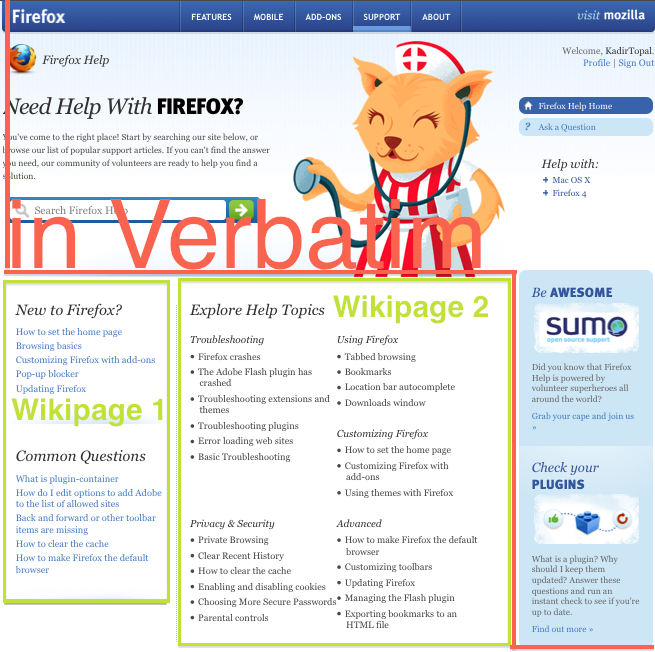Support/Kitsune/KB/FAQ
I'm a new localizer, where do I start?
First things first: There are two parts to SUMO localization. The first part is the user interface (the buttons, text in the sidebar etc.) see below for how to localize that. Then there are the actual articles, they are translated in SUMO, which is a fully localizable Wiki. The things to localize break down as follows:
- Normal articles
- Troubleshooting articles (article explaining how to fix a problem)
- How to (article explaining how to use a feature)
Normal articles are full Knowledge Base articles for visitors, like in any other wiki, with the added benefit that they are localizable.
- Non-normal articles
- Navigation
- Templates/Content Blocks
- How to contribute
Naviation articles: Those articles are special pages, like the startpage, or the Ask a question apge. You'll see them on the localization dashboard, and here is a list of them: /lit not yet ready/
Templates/Content Blocks: Some parts of articles, like how to open the preferences window, are repeated in so many articles, that it makes sense to write those bloks once and have them inserted in article when they are needed. We use Templates for that. A list of all templates is here: /list not yet ready/
How to contribute: Those are articles that are meant for contributors. You don't need to localize them, they are only for people who are registered as contributors, and don't show up in search results.
Your best bet is to go down this list of top 20 articles and templates: https://support.mozilla.com/en-US/kb/top-articles-localize
After that all articles linked from the startpage are good ones to work on since they are the most visible to new visitors.
How to localize the User Interface?
We localize the User Interface on Verbatim: http://localize.mozilla.org/projects/sumo/
Please send an email to atopal%mozilla.com if you don't know what to do on Verbatim.
We currently have two servers for SUMO:
the first one is our real server, called prod. The second one is for testing. Things you translate on Vebatim are automatically transferred to the testing server. We have to manually transfer over strings to prod, which will happen about every two weeks.
How to localize the start page?
The new startpage consists of 3 parts, the upper part with the mascot and the right sidebar are located in Verbatim. The lower left and middle panels are normal Wiki pages:
If you've translated the strings in Verbatim, you're mostly done already, that leaves the left sidebar and the middle panel. In both cases you don't need to translate the linked page titles that you see as bullets points, they will be automatically translated if you have translated the articles as usual. You only need to translate the headings.
Wikipage 1, the left sidebar: https://support.mozilla.com/en-US/kb/home-page-quick
Wikipage 2, middle panel: https://support.mozilla.com/en-US/kb/home-page-explore
When you localize those pages, please keep the English titles, they will not be shown on the page, but if you change them your startpage will break.
Note (smo): you have to be logged in to be able to edit of course. Note, that if you log in on any of these two pages, you will land on the home page, so look closely at the page name before getting confused (as I did;).
How does dynamic content work in the new system?
In this new system we solve the need for content snippets in a broad way: Everything is a wiki article, and behaves like a wiki article with history, localization tracking etc. Templates look like this: [[T:NameOfTemplate]]
Where is the list of all articles?
https://support.mozilla.com/kb/all
Where is the top articles to localize?
Short answer: Here Long answer: We currently don't get a dynamic top 20 list for all SUMO articles. However we are already working on it and the functionality will be back in early January. Until then we will use the page above, and update the list manually once a week.
What kind of wiki syntax do we use now?
The Kitsune wiki is based on MediaWiki with our own special additions. Check out the updated Markup Chart and this wiki article on the new {for}.
How does the minor/major edit system work?
We have 3 levels of edits of English articles in the new system.
- minor edit = Punctuation and spelling errors, no one is notified of this change
- major edit/content change = more than minor edit, but the change doesn’t diminish the value of the localized articles. Only localizers are notified by mail.
- major edits/translation = This major edit changes the content of the article so much that the value of the localization is severely diminished. Localizers are notified about the change and the localized page get an ‚out of date‘ header, telling readers that the article is not up to date anymore.
What does slug mean?
The term 'Slug' appears right below the space where you choose your article title. It's part of the url of the article, like: http://support.mozilla.com/en-US/kb/this-is-the-slug
What are keywords?
Keywords appear on the edit page of an article. They are words that help the search algorithm select the right article. So, if you have bookmarks article, you can give it the keyword 'bookmark', but also 'favorites' for IE users or other words that might be used by people who are looking for the article.
